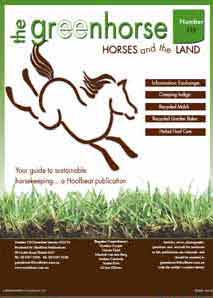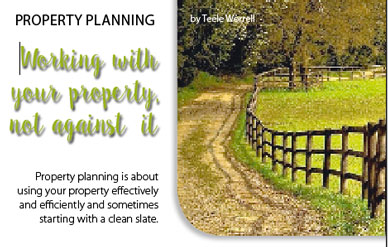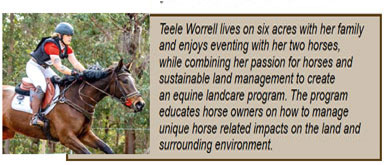The Green Horse section provides practical information on managing environmentally sustainable horse properties, readers stories and tips, as well as advice and articles from equestrian experts in their fields.
December January '22/23
Vol 44 No4
In this issue of The Green Horse you will find the following articles
The European Invader
by Rhiannon Brown – Envirapest
One particular invader that can
cause a lot of pain to your family and pets is the European wasp.
Future Mice Eradication
Tracking Up
by Deidre Rennick
A track system is basically a way to design your paddocks to encourage forward movement and
natural horse behaviours.
Property Planning -
by Teele Worrell
Property planning is about
using your property effectively
and efficiently and sometimes
starting with a clean slate.
Herbs for the Hooves
by Country Park
Herbs can play a supportive part in any hoof issues.
Summer Pests
by Tracy Weaver-Sayer
The very wet conditions have led to
an increase in a number of pests, with mosquito populations in particular booming across many areas and increasing the risk of serious mosquito borne disease outbreaks.
WIN A YEAR'S SUBSCRIPTION...
share your equine property management tips and each issue one reader will win.
Send ideas to -
The Green Horse Support <enquiries@hoofbeats.com.au>


PREVIOUS ARTICLES
Available on line
October/November 22
WHAT IS EQUESTRIAN LANDCARE
by Teele Worrell
Part 1 In a series in which Teele will explore what equine landcare is, and why it benefits equine landholders
August/September 22
THE IMPORTANCE OF GROUND COVER
by Belinda Taylor
Ground cover, whether it be dead grass, weeds, hay, or mulch is the insulating layer that protects your soil from the extremes of temperature and erosion.
June/July 22
SOLAR FOR YOUR ARENA
Environmentally-friendly solar lighting for your arena will allow you to use your arena for longer, and as energy from the sun is free it is therefore an ideal long-term solution for powering lights. Jeff Florence from Blackfrog Solar, Queensland suggsted some solar tips.
April/May 22
MAKING THE MOST OF MOSQUITO CONTROL
by Rhiannon Brown - Envirapest
Climate change that has brought high temperatures, more rain and increases in humidity will provide ideal breeding grounds for the many species of mosquitoes, including those that spread the Japanese Encephalitis virus (JEV).February/March 2022
February/March 22
SUSTAINABLE DEWORMING
by Sophie Fletcher
There has been a relatively big shift in deworming treatment strategies in recent years, due to increasing levels of worm resistance to the chemicals we have been using for decades to control them, resulting in a lot of confusion among horse owners.
December/January 21/22
ARE YOU PREPARED FOR THE FIRE SEASON
In the many areas where horse owners live this season's fire preparation should be well underway; if you’ve not already started preparing your property for summer then now is the time to do so.
October/November21
SNAKE UNIVERSAL ANTIVENOM
The good news is that there is no longer any need for a snake to be identified to administer antivenom. A universal antivenom is now used that covers the five genus of snake that will cause serious harm or death.
August/September 21
BEAT THE BINDI
by Rhiannon Brown - Envirapest
The prickly weeds that grow on our properties across Australia usually have long classical Latin names, are often known by a variety of common names in different localities but are regularly called very rude names when we happen to stand on one (or a dozen) or when they find our hands as we are dislodging tangles in the horse’s mane or tail.
June July 21
BARN OWLS by Wendy Elks
A silent partner in rodent control.
Non-toxic pest management is the most humane and ecologically sustainable way of bringing nature back into some kind of balance during non-plague times.
April/May 21
LOVELY LAWNS
by Rhiannon Brown - Envirapest
On a horse property there always seems to be hectares of grass, but we all have that little bit of lawn we want to look luscious all year round.
It could be the entrance to the stables, laneways bordering the driveway, that little ‘special’ snack paddock or you could even dream of a beautiful green arena. So, how do we achieve this?
Feb/March 21
STABLE DANGERS
by Elizabeth Tollarzo
They say that horses are accidents-waiting-to-happen as they are inclined to find every conceivable way to injur themselves, usually just before a competition. Being aware of potential dangers in the stable - and addressing these - may help aleiviate injury.
Dec/Jan 20/21
HORSES AND HONEY BEES-
Can they share space on the property?
by Wendy Elks
Oct/Nov 20
SOLAR-POWERED PRODUCTS
by Celine Bønnelykke
In previous issues we have discussed the economics of setting up a solar-driven property, but if finances don’t stretch to installation of the whole package, there are ways to ease into the solar-world.
Aug/Sept 20 THE HIDDEN DANGERS IN OUR PADDOCK.
by Elizabeth Tollarzo
Horses love to run, play, buck and then run again and we often, through lack of risk assessment or management practices, place them in areas that are fraught with dangers.
JUNE JULY 20 GOING SOLAR ON THE HORSE PROPERTY Where to put your panels Part 2
Once you have selected what solar system best suits your needs, then you need to look at how you can maximise the advantages.
APRIL MAY 20 GOING SOLAR ON THE HORSE PROPERTY Part 2
Once you have selected what solar system best suits your needs, then you need to look at how you can maximise the advantages.
FEB/MARCH 20 ANTS AWAY
by Mark Brown Envirapest
So, what can you do to deter ants from your house and your stables??
DJ19/20 KEEPING SNAKES OUT OF THE STABLE by Wendy Elks
Snakes may be protected under Wildlife regulations in Australia, and they may be great for keeping the mice and rats down, but do we want to find them in our stables near our horses and pets?
ON19 - TERMITES- common myths
by Rhiannon Brown, Envirapest
Your house and stables are looking wonderful this spring, but do you know what is happening inside the walls of your brick or timber building?
AS19 - OUCH THAT HURTS
by Catherine Bird for Country Park Saddlery
The extent of the swelling is usually an indication of the severity of the infection or injury and the cause needs to be established before giving herbs.
JJ19 - MANAGING PASTURE
by Rhiannon Brown, Envirapest Healthy pasture means healthy horses.
A/M19 - STOP THOSE WEEDS
Property biosecurity
by Rhiannon Brown, Envirapest
Putting simple precautionary steps into place can make it tough for weeds to get a hold on your equine paradise.
|
  
  


As a landcare officer Teele Worrell has spent years delivering events for horse owners, educating them on sustainable land management techniques tailored to the challenges of owning horses. One presentation, appropriately titled ‘Protecting your land from the ones you love’, went through five important themes of equine landcare, the first covered What is Landcare? Part 2 looks at Property planning.
When a landholder is ready to look at property planning, I always encourage a fresh look. Imagining your property without the current infrastructure could help you get the most out of the experience. Printing out an aerial map of the property is a goosd place to start.
No one wants to hear ‘why don’t we move some of the fences’? but the long-term benefits from using your property effectively can outweigh the pain of any initial investments. If you could change anything about how you use your property would you? And what is holding you back?
Every property will have strengths and weaknesses but property planning can help to minimise negative impacts and take advantages of the strengths.
For example, if you keep horses on sandy soils, then your soil will have good drainage but won’t hold up well to sustained grazing pressure, while properties with clay soils hold up well to pressure from grazing but can become waterlogged during winter.
Once you understand your property’s strengths and weaknesses you can modify your management. Using your property more wisely will improve the health and resilience of your land making it more productive.
Management options could include the creation of a sacrificial area to reduce the time horses spend grazing on sandy pasture, allowing the soil structure to stay intact.
Property owners with clay soils can leave horses on pasture for longer without seeing soil structure break down but may need to remove access to waterlogged areas during winter, in turn those areas can then provide summer grazing opportunities.
Property planning will save you time, effort, and money.
One way to save time is to build a pathway system for your horses allowing you to reduce the amount of watering points that need checking and maintenance. This is an additional benefit to reducing the time horses spend grazing on pasture while encouraging horses to move more.
An important part of property planning is incorporating emergency management into any future development.
Making changes? Can additional gates be included to allow for improved evacuations or to provide a pathway to a safe place for your horses to go in the event of a fire? Can higher areas be fenced in a way to provide an evacuation site in the event of a flood?
Successful equine landcare takes time. Property planning can help you use your properties strengths to help keep your horses and land healthy while also navigating any weaknesses that may require extra management.
 |